All posts by sevenfiguresel
80/20 of E-Commerce Newsletter – February 02, 2024
Amazon soars Q4, US economy at risk, 6 Bridges to Japan – From Hokkaido
Hey Everyone,
This week I’m writing to you from snowy Hokkaido Japan. It was my birthday last week and my family and I are taking a trip in the northern part of Japan.
Even in the most remote areas of Japan, Amazon fulfills.
I even got snow gloves and a sleigh for my son delivered here by Amazon Prime Japan!
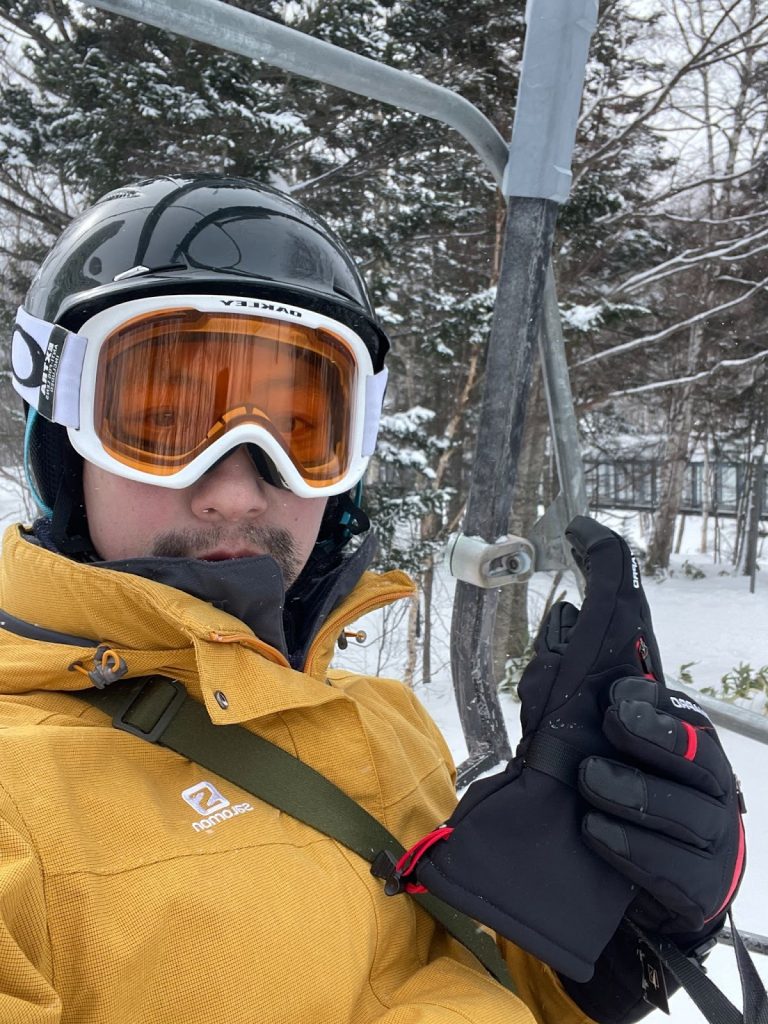
There are some highs and lows to report in this week’s edition of the 80/20 of Ecom newsletter.
Q4 was a record-breaking Holiday shopping season and closed out a robust 2023 for Amazon
According to EcommerceBytes “Amazon grew sales 13% in the fourth quarter of 2023, the same for each of its segments – North America, International, and AWS – when factoring out the impact of exchange rates.”
The recent 2023 numbers show improvement as “North America segment operating income was $6.5 billion, compared with an operating loss of $0.2 billion in fourth quarter 2022; and International segment operating loss was $0.4 billion, compared with an operating loss of $2.2 billion in fourth quarter 2022.”
Amazon FBA 3rd party sellers continue to account for the majority of sales on Amazon as they accounted for “61% of worldwide paid units” in Q4.
Takeaway: Amazon continues to be the dominant ecommerce platform worldwide as growth and margins improved in Q4. Also 3rd party sellers continue to be the dominant force on Amazon.
The U.S. economy may be at risk due to the Red Sea disruptions
This problem is getting serious guys.
The US government House of Representatives Coast Guard and Maritime Transportation held meetings this week to review the shipping problems caused by the Houthi rebel pirate attacks on commercial ships along the Red Sea.
For US importers, the most affected route is from Asia/China to the US East coast because traffic is being diverted south of Africa (Cape of Good Hope). This adds hundreds of thousands in fuel costs and thousands of more miles in distance.
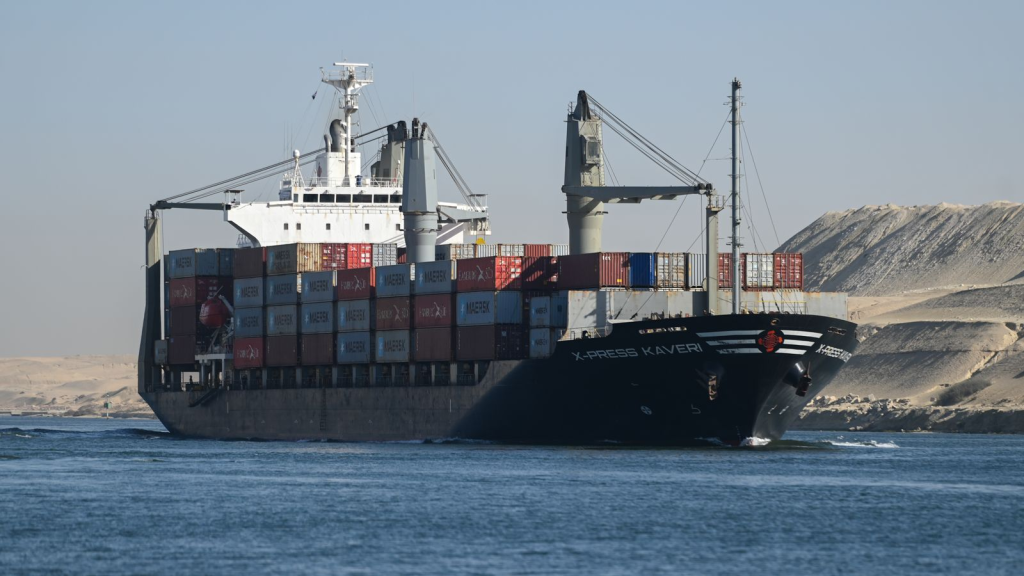
Source: Sayed Hassan via Getty Images
To avoid the backlog shippers are diverting traffic from Asia to the West Coast (e.g. Long Beach).
Then they are using rail to move the goods inland to the get the products to the east coast final destination.
This is causing longer lead times and delays.
And added costs.
“Rail dwell times are starting to tick up, and that rail car imbalances combined with increased demand could later lead to even greater congestion and dwell.”
“Shipping experts warned of possible congestion and higher inflation if the situation prolongs.“
Now’s a critical time to review your supply chain and gauge whether to source closer to your marketplace or diversify to other sourcing destinations and marketplaces.
Amazon looks to improve inbound fulfillment processes in 2024 | Supply Chain Dive
The master of shipping Amazon is using Generative AI to make their logistics even more efficient.
The best is getting even better.
Amazon President/CEO Andy Jassy said on a recent earnings call “Amazon aims to improve its inbound fulfillment processes and inventory positioning this year as part of its continued push to reduce costs in its logistics network.”
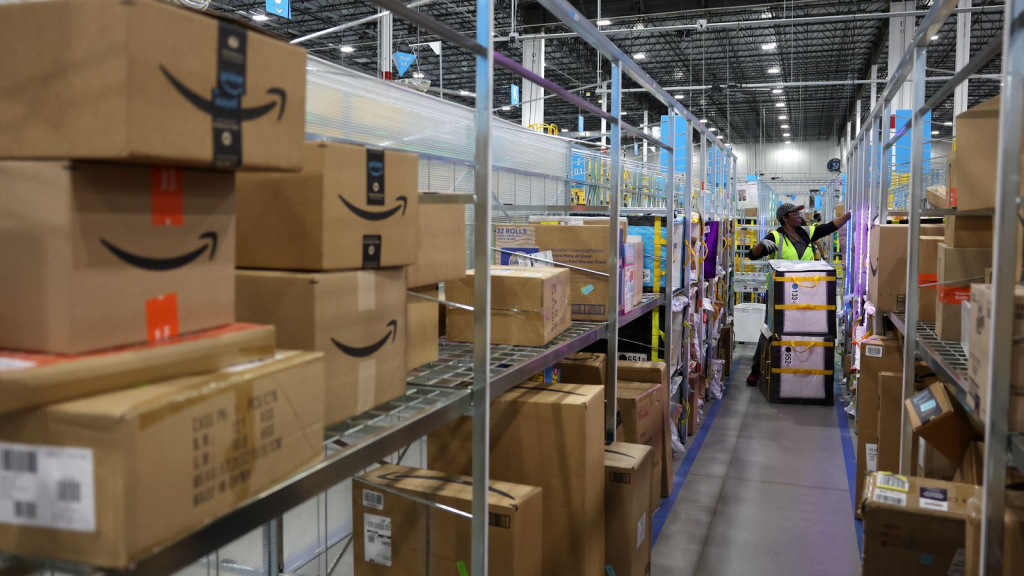
Source: Justin Sullivan via Getty Images
According to Supply Chain Dive “Amazon is using generative AI to help its inventory positioning efforts, as it has built an application using the technology that forecasts how much inventory it needs in each of its fulfillment centers” according to CEO Andy Jassy.
Takeaway: If even Amazon is using AI to optimize their supply chain and logistics to cut costs – we should definitely learn from them. How can you use tools like AI to cut your shipping costs? Make shipments more efficient. And boost your bottom line?
6 Bridges to selling on Amazon Japan – 40 min training
Given the ongoing supply chain challenges and the fact that Japan is right next to the source, it makes sense to consider Amazon Japan as a marketplace if you want to expand your business in 2024.
I know many of you have questions about selling on Japan so I’d like you to signup for my “6 Bridges to Selling on Amazon Japan” at the “Convert More Clicks Summit” online on Feb 8th.
I will walk you through each of the 6 Bridges to sell onto Amazon Japan and what tools you can use to get started right now (even if you don’t speak the language).
You can [REGISTER HERE] for $9.
I put a lot of time and effort into making this a valuable training for you. If you feel it adds value, I would appreciate it if you would vote for me for the “Most Valuable Presentation”.
7 Figure Seller Japan Mastermind in Okinawa, Japan Apr 8-10, 2024
Japan is the niche that smart Amazon sellers are focusing on in 2024.
Did you know that in Japan, a “bestseller” yoga mat only has 3.9 stars and 373 reviews!?
This is a prime marketplace, 4th biggest Amazon marketplace in the world and growing.
This is a 3 day in person event in Okinawa Japan where you will learn:
- Updated 2024 Roadmap how to sell on Amazon Japan
- New strategies to sell on Rakuten Japan
- How to get into offline retail stores
- External marketing strategies to instantly generate more sales
- How to use AI to scale your business in Japan without speaking the language
You also will mastermind with 7 and 8 Figure Amazon Japan sellers like Nick Katz, Brandon Young, Tim Jordan and more.
But we are keeping this mastermind intimate to maximize the experience for each seller. You will get all your questions answered on how to sell up to an additional $300k to $965k in Japan in 2024.
Limited tickets are still available at https://7figuresellerjapanmastermind.com/
Thanks
Gary
Why should you care about selling on Amazon Japan?
3 Myths and 4 truths about Amazon Japan
When it comes to ecommerce and Amazon selling, everyone knows that the most important thing is selecting a profitable product to sell.
Well before even selecting the product, most sellers overlook the fact that they need to select the right marketplace to sell in.
In fact, Japan is the 4th biggest Amazon marketplace in the world and still almost nobody is talking about it.

Here are some additional facts about Japan
- Amazon.co.jp is the #1 ecommerce site in Japan with revenue of US$13 billion in 2021
- 93 million online shoppers in Japan with an Ecommerce penetration rate of 74%
- Ecommerce is forecast to grow at a yearly rate of 6% in Japan
- Japan has a population of 126 million (2021) which is DOUBLE the population of the UK
- Japan has the 4rd largest GDP in the world
But one key thing people overlook is this…
There’s far less competition, unsophisticated, weaker competition in Amazon Japan.
In terms of absolute numbers, Japan has far fewer sellers than other major marketplaces. In fact it was ranked #8 in number of sellers behind smaller marketplaces like Italy, France, and Spain.

Moreover the competition is a lot less sophisticated in Japan than other countries.
For example some foreign sellers don’t even bother to translate their listings from English to Japanese. They even entered English into the description and in the backend. They’re doing NOTHING to win over the Japanese customer so the bar is set really low in Japan when you have these lazy competitors.
Take for example this is the listing that has the Bestseller badge for “Thick Yoga Mat” in Japan.
It only has 3.9 stars and 429 reviews.
Note that the seller didn’t even bother translating the infographics into Japanese (they are left in English!)
You don’t need to be the best seller in the world to compete and WIN against weak competition like this.
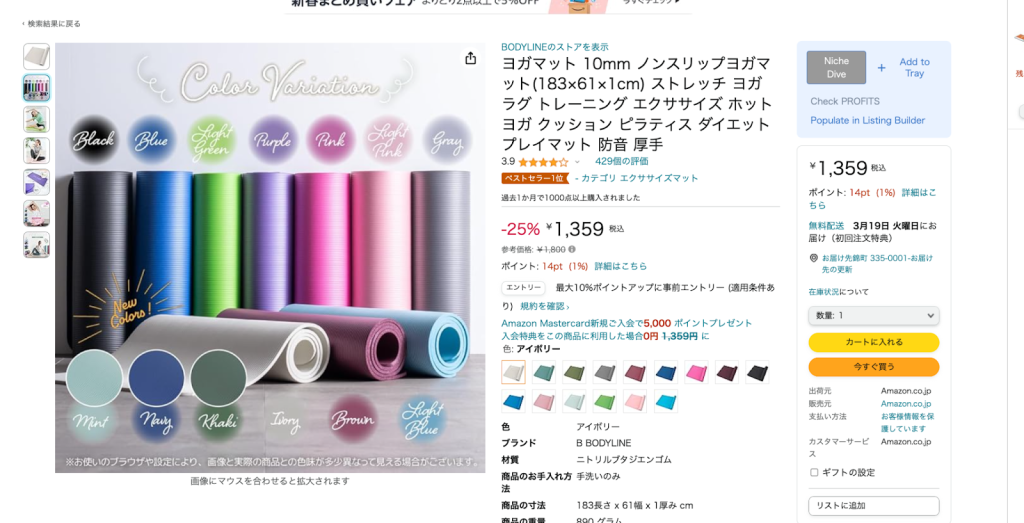
In addition, Japan has tremendous supply chain advantages
As the world keeps changing and we are hit with black swan events like the Suez Canal crisis and pirates firing at container ships which are driving up shipping container costs 2x-3x and adding weeks to shipping times, Japan enjoys a tremendous advantage because it is China’s neighbor.
You are going close to the source and you will save a ton of MONEY and TIME on shipping.
In fact it only takes 7-10 days for a product to ship from China to Japan versus 30-45 days (or more) from China to the US.
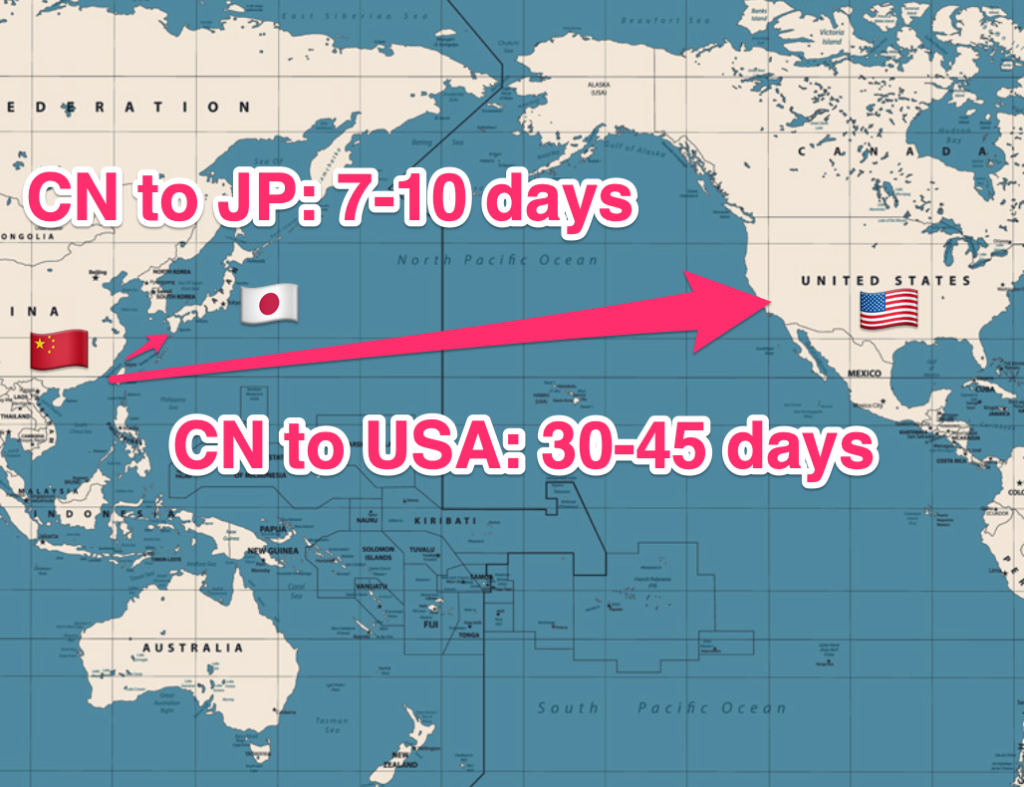
But at the same time it can be intimidating to sell into Japan.
I’d like to debunk some myths about selling in Japan
MYTH 1 – You have to know Japanese to sell in Japan
FALSE – You can sell in Japan without knowing Japanese (I’m a case in point)
Recently I was talking with Ecommerce veteran and host of the AM/PM Podcast Kevin King about selling on Amazon Japan.
Then something interesting came up.
Kevin King asked me how do you get started selling on Amazon Japan?
I said first you need to figure out your Product Market Fit for Japan. You need to do product and keyword research.
Kevin said “I don’t read Japanese. How do I do that?”
I told him I don’t really know Japanese either and I did it.
So I told him
– Which tools to use
– Where to look
– How to make sense of Japanese keywords if you don’t know the language
– So you can launch your product in Japan with less risk and more confidence
He was blown away – he didn’t know you could do that for Japan if you don’t know Japanese.
And we did a training where we show you exactly how to do this. – https://youtu.be/rBp9bwfn4WA
MYTH 2 – You need a Japanese company to sell in Japan
FALSE – You do not need a Japanese company. In fact you need a what we call an ACP (learn more here)
MYTH 3 – You need to register for JTC (Japan VAT equivalent)
FALSE – when you first start selling in Japan you can sell without getting a JTC number – save this for later until you cover a certain sales threshold.
In fact if you are already selling on Amazon US or Amazon UK, Germany or other marketplaces you have many advantages selling into Japan.
ADVANTAGE 1 – REVIEWS
If you already have a seasoned listing in Amazon US or Amazon’s EU marketplaces, you can carry over the listing and the reviews.
This means if your SKU has 700 reviews on Amazon.com then you can essentially launch on Amazon JP with 700 reviews.
And with fewer competition the average review threshold in Japan will be much lower than in other marketplaces.
This means that you will enjoy higher conversion rates as well with your existing reviews launching into Japan.
ADVANTAGE 2 – Amazon Seller Central in Japan is in ENGLISH
If you are already familiar with Amazon US Seller Central then you will feel right at home in Japan as the menu and navigation is virtually the same.
ADVANTAGE 3 – PPC costs in Japan are much lower than US or EU.
According to a recent case study by PPC Ninja, average PPC costs in Japan are as low as $0.29 per click which is nearly unheard of in other Amazon marketplaces.
ADVANTAGE 4 Product Research tools are available for Japan
You can do product and keyword research tools with your exiting tools such as Helium 10, Jungle Scout, and Data Dive, all of whom support Amazon Japan.
Moreover, even Pickfu now supports Japan so you can do additional market research using familiar tools.
All in all these are the reasons why Japan should be on your Amazon Selling Radar in 2024.
If you’d like to accelerate your selling into Amazon Japan, I would like to invite you to a 3 day in-person event in Okinawa Japan from Apr 8-10.
You will learn the exact roadmap on how to sell up to $965k on Amazon Japan in 2024: https://7figuresellerjapanmastermind.com/
Hope to see you soon,
Gary
Will my product sell on Amazon Japan? 12-question Product Decision Tree
Are you curious “Will my product sell in Japan?”
If so, I’ve distilled down dozens of factors to 12 yes or no questions.
This will give you a quick gauge IF Amazon japan is a great opportunity to expand your business in 2024.
I call it the Amazon Japan Decision Tree.
First off, I recommend you set aside 5-10 minutes to go through the 12 questions and keep track of your Yes or No answers.
By the end of this Decision tree you will know “Will my product sell on Amazon Japan”.
It’s not 100% foolproof but it will give you a strong indication and reduce your risks.
Let’s dive in.
1) Are you selling a product with at least 300 reviews on an Amazon Marketplace other than Japan? (Add 1 point if Yes)
If yes, then you can carry over to Amazon Japan and launch with the same number of reviews from Day 1.
Review thresholds are much lower in Japan and you will be at an advantage from your launch.
2) Is your product manufactured in China? (Add 1 point if Yes)
If Yes, you will eliminate US-China tariffs and get at least 25% cost reduction on landed costs
And you will enjoy shorter lead times as low as 7-10 days shipping from China to Japan which will let you place smaller orders (and free up your cash flow)
3) Is your product manufactured in India, Vietnam, Thailand, and other free trade countries with Japan? (Add 2 points if YES)
If yes, you may lower your duties to as low as ZERO. This is more cost reduction on landed cost and more profit margin for you.
4) Does your product have a chance to go VIRAL on social media? (Add 1 point if Yes)
For example it’s not a boring product like a trash bag or masking tape.
Japanese consumers love to follow the crowd.
5) Does your product have any influencers on Youtube, Instagram, Tiktok? (Add 1 point if Yes)
If so, then there’s a strong chance you can drive a ton of external traffic to your listing in Japan because influencers are big in Japan.
6) Is your product SIZE compatible with Japan? (Add 1 point if Yes)
Japanese apartments, especially in Tokyo are TINY. You will need to consider if your product is TOO BIG for the market.
For example large patio furniture will not work because Japanese apartments DO NOT have patios.
As a rule of thumb very LARGE or Oversized products may not have product market fit for Japan.
Youtube is a great way to check how your product will fit (or not)
7) Is there a large Market for your product in Japan? (Add 1 point if Yes)
Use the Amazon Product Opportunity Explorer, Jungle Scout, Helium 10, or Data Dive to research the top search results onAmazon.co.jp for your main keywords. – how many sales are there?
For example, are there 5,000 sales per month in the top 10 listings combined?
That means there’s a significant market for your product
8) Are there 5-10 Keywords on Amazon JP that you can rank for? (Add 1 point if Yes)
Search on Amazon.co.jp for competing products using english keywords.
Then use tools such as Helium 10 and Jungle Scout to do a reverse ASIN search to find out your keywords in Japanese.
You can also use ChatGPT to translate these keywords into Japanese and/or English.
9) Does your product have Low Competition in Japan? (Add 1 point if Yes)
Goto amazon.co.jp and search in English for your keywords.
Look at the top 10 competitors for your product – are there at least 5 sellers with less than 300 reviews?
If so then there’s a good chance of success for your product.
10) Does your product have Low Compliance complexity? (Add 1 point if Yes)
This means you are NOT selling anything that goes ON THE BODY or IN THE BODY? (Supplements, cosmetics, etc)
Also anything that does NOT touch food or drink (e.g. water bottle)
If If so be prepared for more regulations
11) Does your product have fewer than 5 components? (Add 1 point if Yes)
In Japan compliance tests are often required for each component. This means that if there many different parts, there will be higher compliance costs as each part may need to be individually tested.
12) Is your product a cultural fit for Japan? (Add 1 point if Yes)
Taco holder test – is your product like a taco holder or something that is very US-centric? Just so you know most Japanese ppl don’t eat tacos so there is little demand in Japan.
This may be hard to gauge if you’re not familiar with Japanese culture.
But there is a quick hack to get 95% certainty.
Ask ChatGPT “Do Japanese people use (XXX product)?”. (Replace with your product keyword)
Then fact check then answer against Amazon.co.jp and/or Youtube.
OK now it’s time to calculate your score.
Add up all of the YES answers and if you totaled:
8-11 Yes – Very strong chance of success in Amazon Japan – This is one of the most important things you should do in your business in 2024
I would then look deeper into this
- How to do Amazon Japan Keyword research (without knowing Japanese) – Watch this training – https://youtu.be/rBp9bwfn4WA?feature=shared
- Find out your product compliance testing requirements for Japan (Cost of the price of a Starbucks coffee) Contact Yunige at https://service.yunige.info/compliance/checkId Enter code 7FSJM for a discount
4-8 Yes – Good chance of success in JP
Your product has Good product-market fit and you should find more details to make a decision – see above
1-3 Yes – Lower chance of success in JP
This product may not be the best product market fit at this time. Consider other products.
0 Yes – Do not enter Japan yet
Consider different products and different strategies.
Note: if you did score below a 4 – it is NOT game over for your product in Japan.
There are ways to quickly pivot and tweak your products to make them sell well in Japan… without having to start over from scratch. One way is to make different product variations that can cater better to the Japanese marketplace.
I suggest you run the variation through the 12 question decision tree to see if you can score higher.
Notice I didn’t put anything about language or translation because that can be solved using a translator and commonly available tools like ChatGPT.
By the way, if you took the test let me know what score you got? Was this helpful?
Gary
PS: If you scored between 4-11, I highly recommend you take action this year and join us at 7FSJM2 – to learn the updated 2024 roadmap on how you can sell up to $965k in Japan.
The 6 Bridges to sell on Amazon Japan
The obstacle is the way – how to overcome your biggest challenges selling in Japan Date: 2/2/24 11pm JST
Hi Everyone,
“The Obstacle is the Way” is a book by Ryan Holiday which perfectly summarizes the journey to selling on Amazon Japan.

Selling on Japan can be intimidating – in a recent survey where I polled over 130 sellers interested in selling on Amazon Japan what was their #1 challenge – here’s what you told me.
- Language barrier
- No understanding of what is involved
- Total ignorance of the marketplace
- The steps setting up my seller central
- Opening an account (not just Amazon Global Listing)
- Having the FBA there with the stock in the country
- Legislation rules of entering are not transparent
- PPC Ads of course is an obstacle because of language
- Traditional marketing does not work
- Regulations (Importer of record)
- Proper listing translations
- Food Import Requirements
- And more
It’s easy to view these challenges as obstacles, but in reality they can be some of our greatest strengths.
Take for example Chris Davey, 7 Figure Seller who sells on Amazon EU, who explains that all of the European VAT, compliance, and bureaucracy that he has to deal with selling on Amazon EU are in fact a MOAT against his competitors.
He sees these challenges as benefits to actually prevent his competitors from entering this market.
Since Chris has found the way to turn these adversities into advantages, he is enjoying the results of this and is thriving in the Amazon EU marketplace as a result.
Coming back to Japan, these challenges are all surmountable.. Even if you don’t speak the language (like me).
So I’ve distilled these challenges you’ve shared into the “6 Bridges of Amazon Japan”.
These are the 6 bridges that sellers must cross in order to sell into Japan.
Bridge 1: Product-Market Fit: Will my product sell in Japan?
“What are the niches that best suit this marketplace?”
“How can I verify the demand for my designs in Japan (culturally?)”
This is the million dollar question.

To answer that you need to gauge 4 key variables
Market Size – Amazon Product Opportunity Explorer
This is a tool from Amazon that will help you size up how big the market for your product is in Japan.
Best of all, this data is directly from Amazon so you can trust it is 100% accurate.
Keyword Search Volume – Helium 10, Jungle Scout, and Data Dive all support Amazon Japan.
You can use them in a similar way as you do for keyword research in the Amazon US or EU marketplaces.
Competition – Amazon.co.jp
First some good news – Amazon.co.jp has an ENGLISH language setting. Simply set it to English and you can get all of the Japanese product listings translated to English.
It is not 100% but it is more than enough for our research purposes right now.
So do a simple search on Amazon.co.jp and you will find out which of your competitors are already selling in Japan.
You may be pleasantly surprised that most of them are not there yet = BIG OPPORTUNITY
Culture
But perhaps my favorite tool to learn about the Japanese marketplace and how my product may be used is YOUTUBE

“Idiot’s guide to Japanese Kitchens” Source: Youtube
If you sell a kitchen product, you can “walk through” a Japanese kitchen by searching for “japanese kitchen walkthrough” on Youtube.
This will help you visualize and better understand how Japanese people use your product (or if they use it at all).
By following the steps and the tools above you can get a better idea of product-market fit for your product in Japan and whether your product will sell in Japan.
Bridge 2: Japanification – localization
There are 4 key things that Japanese shoppers pay attention to when shopping online according to Ritu Java, who is a Japan localization and PPC expert who has lived in Japan for 17 years.
1) Language
2) Aesthetics
3) Details – Focus on Data
4) Culture

These are the 4 levers to pull when localizing your product to Japan.
All of them can be done by sellers who don’t speak Japanese.
Language
I’ll be honest – Japanese is a tough language. There are 4 scripts that are used in various situations.
The best way is to hire a native speaker that has Amazon copywriting experience to help you translate.
The quick way is to use ChatGPT. It is miles ahead of Google translate and can help generate a draft of your product listing translation into Japanese.
But I recommend you hire a native Japanese speaker to check and polish it before going live with the listing.
In terms of actually selling in Japan however, the good news is that Amazon Japan Seller Central can be set to ENGLISH.
This means if you’re already familiar with US or EU seller central – you will feel right at home setting up to sell in Amazon Japan.
Aesthetics – Japanese people love to beautify the packaging.
Take for example the art of gift giving in Japan. If you go to a Japanese department store, the basement level will have a whole floor dedicated to selling sweets.
When you buy a box of sweets, the staff will elaborately gift wrap it as if you were a King or Queen.
That is the level of aesthetics Japanese people expect.
Details and Data
Japanese people love details. Take for example a box of wet wipes.
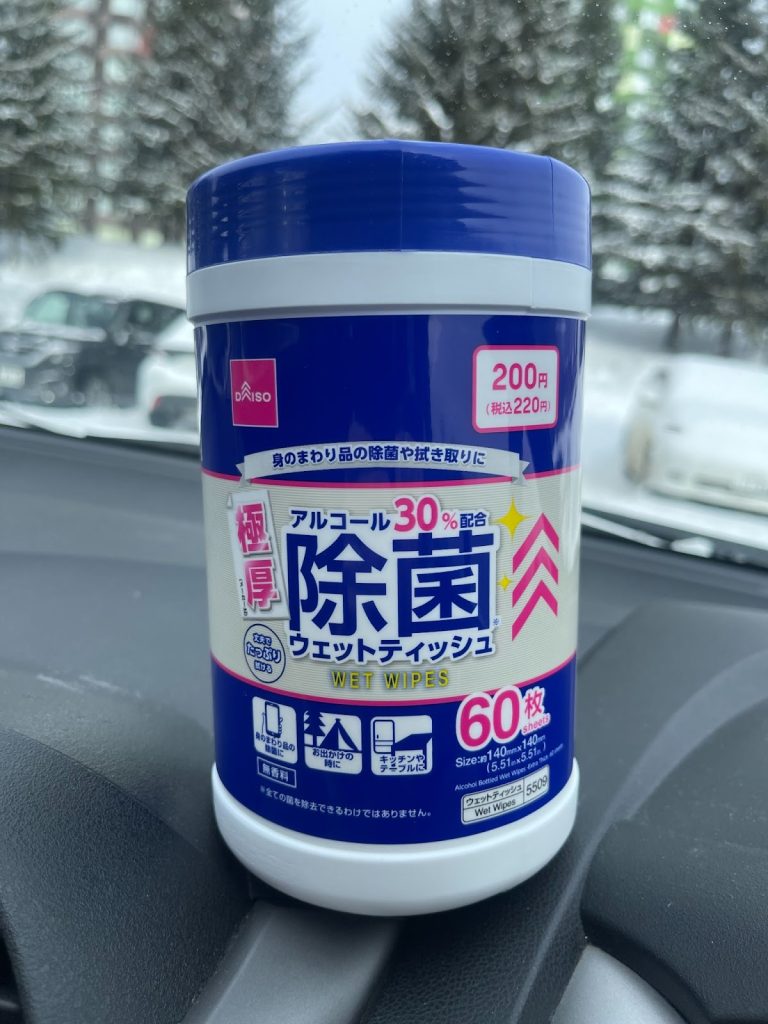
You can see the level of details on this box with
- Alcohol content
- Size
- Thickness
- Exact uses (Devices, outdoors, kitchen, etc)
- The number of wipes
- And much more detail that most Americans would expect for a simple pack of wet wipes
This is all to build trust in the shopper’s mind and increase the chance of the sale.
Culture and Respect
The language and tone of the copywriting must be more polite than your usual copywriting for the US market.
A big “no no” is to say that you are a small family business and to thank them for the purchase.
That is not culturally appropriate in Japan!
Bridge 3: Import and Compliance
“Are there any limitations on what type of products can be sold and are there ways around the limitations?”
Japan has complicated import and compliance laws – but the good news it this is easily surmountable if you find the right agency that can help guide you through the forest of Japanese import laws and regulations.
One example is with a kitchen product that I used to sell in the US market.
Several years ago I considered selling this into Japan and I did the keyword research and ran the numbers.
I got excited because none of my competitors were selling in Japan.
This could have been a wide open market.
However I emailed an import compliance company and they recommended NOT to import this product to Japan.
I found out that one of the components used for this product was illegal in Japan for the general public. It could only be sold to professional restaurants and cafes.
Fortunately I spoke with a Japanese import/compliance agency which saved me a ton of headaches down the line.
Bridge 4: Shipping, Logistics, and 3PL
This challenge is actually a big benefit because Japan is in the same region as your Asian suppliers.
Japan is next to China, not far from India, Vietnam, and Thailand.
This means that you will save time and money shipping your product from your factory to the Amazon Japan fulfillment center.
We are talking about only 7-10 days versus 30-45 days or more.
Also shipping costs will be significantly lower.
If you are a 7 or 8 Figure Seller this should be a light bulb moment because this can free up your cash flow so you can have less money tied up in product inventory since you can turn your orders faster.
In other words rather than keeping 3-4 months of inventory in stock you can effectively shave that in half depending on your inventory management.
Another big benefit is that there is no US-China Trade war in Japan.
Therefore you will shave off 25% or more tariffs from your landed costs.
Also Japan has many free trade agreements with India, Thailand, Vietnam, and over a dozen other countries across the world.
This means you will lower your landed costs more.
That can instantly help improve your margins and profitability compared to sourcing from China and selling in the US or EU.
The key takeaway is that selling in Japan will be a logistical and cash flow ADVANTAGE to your business once you calculate the costs.
Bridge 5: Launch Strategy
Every seller wants to launch their product with a BANG.
The goal is to take advantage of the “honeymoon period” when your product first launches to lock up a high ranking on page 1 of your search results on Amazon.
If you are already selling on Amazon US or EU or any other marketplace – good news.
You can CARRY over your reviews from Amazon US/EU/other markets to Amazon Japan.
This means if you have 700 reviews on Amazon.com (US) you can launch with 700 reviews on Amazon Japan from Day 1.
One other advantage to the lower competition on Amazon Japan is that the review threshold is lower.
As we saw earlier this week, the best selling “thick yoga mat” in Japan only has a 3.9 star rating with 373 reviews.
The US best seller has 4.6 stars and over 70,000 reviews.
This means that if your review count was in the middle of the pack on Amazon.com, you could potentially be leading the pack on Amazon Japan.
You can instantly have social proof with your reviews to build trust for Japanese shoppers and increase your conversion rates and sales.
Bridge 6: Marketing and Advertising optimization.
Once you have your listing localized and selling the next step is to pour fuel on the fire with marketing and advertising.
In terms of Amazon PPC, there are many new promotions added in 2024 and you will get even more rich data from Amazon.
And the good news is that Amazon PPC costs in Japan are lower than Amazon US and EU on average.
So you will likely get better ROI from your PPC ad spend.
In addition, Japan has a “follow the crowd” mentality.
This means that Japanese influencers are a great way to make your product go viral and skyrocket your sales.
In terms of social media, the #1 social media app is Line with a 82.5% penetration rate.
7 Figure Japan seller Nick Katz says that he builds a list of his customers on Line.
And every time there’s a holiday in Japan, he sends a message out on friday and sunday.
And he literally crashes his web server every time he does that (for non Amazon sales) because shoppers are expecting sales around holidays.
These are great ways that you can scale your business through marketing on Amazon Japan.
These are the 6 Bridges to Selling in Japan.
Remember the Obstacle is the Way – by doing the work and selling on Japan the right way, you will be able to build a defensible moat around your business as you expand into a new marketplace in 2024.
Bonus: I will give a 40 min training on the 6 Bridges to Selling on Amazon Japan in further detail at the “Convert More Clicks Summit” online conference on Feb 8th.
There is a small registration fee and I feel if you got value from this, it definitely will help you more as I cover the 6 bridges in greater depth and with more visual examples.
https://www.dropbox.com/scl/fo/zziufkqv7dku7cum2ibyy/h?rlkey=g5big9ovu51tsemfo6shf0ssi&dl=0
I put a lot of time and effort into making this an A+ training for you. If you feel it adds value, I would appreciate it if you would vote for me for the “Most Valuable Presentation”.
Thank you.
Gary
PS: If this was helpful and you are serious about selling on Amazon Japan – I’d like to invite you to join me and 7 and 8 Figure Amazon Japan sellers at the 7 Figure Japan Mastermind in Okinawa Japan Apr 8-10, 2024. Learn more here: https://7figuresellerjapanmastermind.com/
How to optimize your sourcing and shipping costs and be more profitable in 2024
Right now there are TWO FACTORS affecting your sourcing and supply chain time and costs. If you don’t plan ahead, your ecom business could SINK in the midst of this storm.
FACTOR 1: The Suez Canal crisis is increasing ocean freight shipping costs 2x to 3x.
If you haven’t already seen on the news, there literally are pirates shooting missiles at shipping container ships! It sounds like a scene out of a “Pirates of the Caribbean” movie but this is real life and this is affecting your business whether you realize it or not.
The Suez Canal was a shortcut for containers traveling between Asia to the Middle East and Europe. Now to avoid being shot at, the ships need to take the long way all the way down south of Africa, past the Cape of Good Hope.
And then North back up Africa to Europe and the Middle East.
At the end of the day looking at global shipping container prices that are 2x to 3x the container costs. And this is affecting you even if you’re not shipping to Europe.
China to West Coast US (Long Beach, etc) have doubled as well from Dec to late Jan 2024.
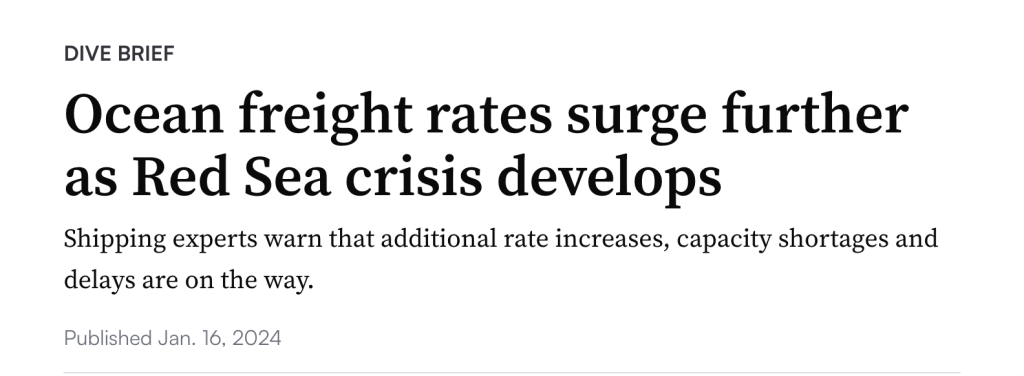
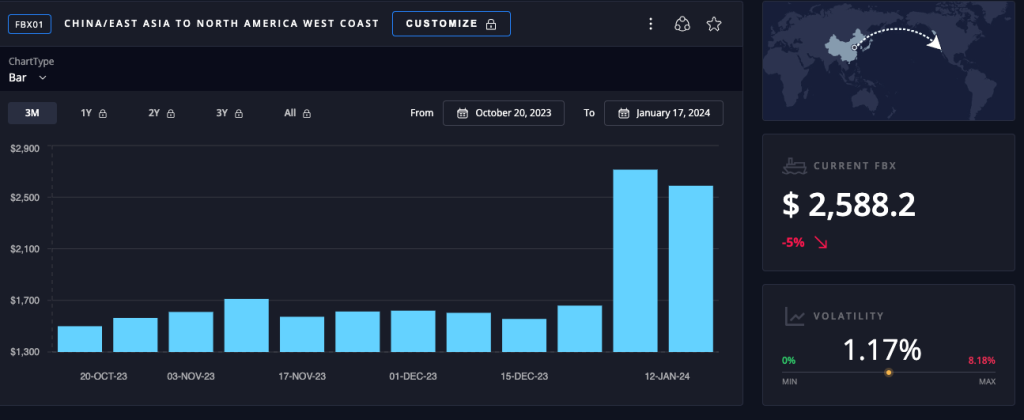

So why should you care as an Amazon and Ecom seller?
The inflated shipping costs are impacting your product landed costs and it’s cutting into your margins if you want to be price competitive in 2024.
FACTOR 2: Chinese New Year Shutdowns
This is an expected disruption but every year around late-Jan to mid February, all of China shuts down to observe the longest holiday of the year – Chinese New Year.
This means that your factory, your sourcing agents, the raw material supplier, your inspection agency, your logistics partners, EVERYBODY in China will be on vacation for up to A MONTH.
While we wait for China to come back, this is a critical time to review how your sourcing and supply chain is performing for you.
These disruptions, combined with soaring expenses, a soft economy, and increased competition, underscore the urgency to keep costs competitive as we aim to have a profitable 2024.
That’s why the TAKEAWAY is this:
Right now is the time smart sellers are optimizing their supply chains
One way to do this is to sell close to the source to bypass this fiasco altogether.
One of the best ways to do that is to sell into Japan. Doing this bypasses the Suez Canal because China and Japan are neighbors.
You are going close to the source and you will save a ton of MONEY and TIME on shipping.
In fact it only takes 7-10 days for a product to ship from China to Japan versus 30-45 days (or more) from China to the US.
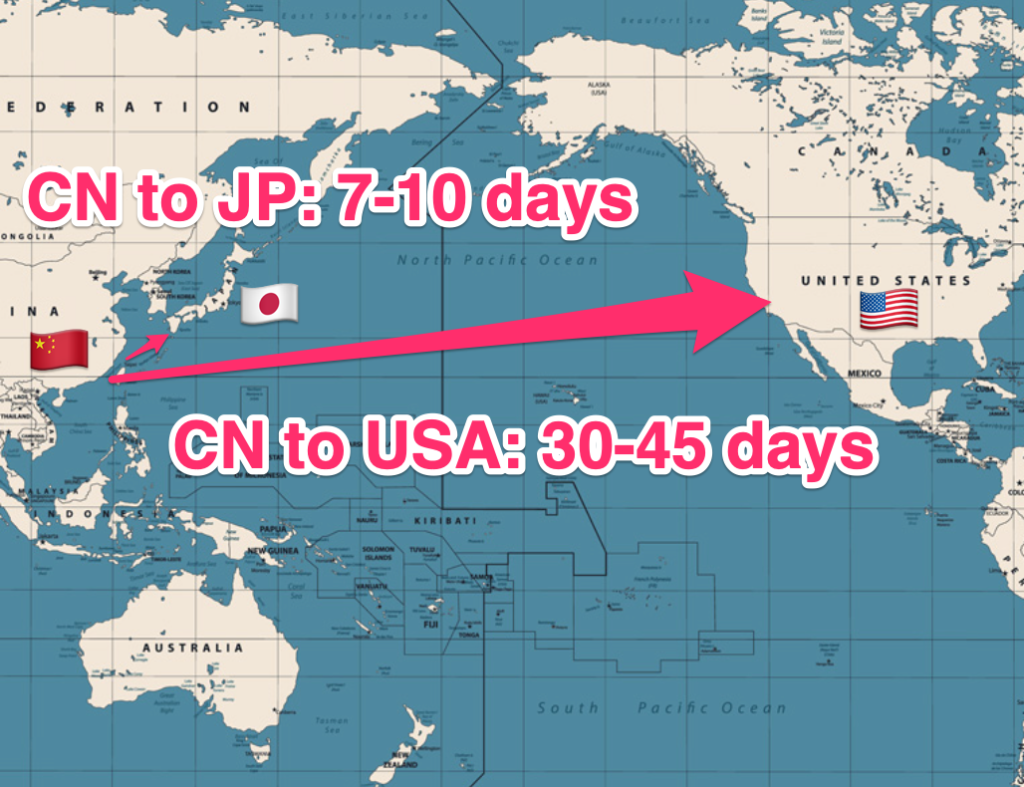
Last year I spoke with Brandon Young, an 8 figure seller selling on Amazon Japan and after explaining to him the short shipping times from China to sell into Japan, a light bulb went off in his head.
He concluded it was a no-brainer to sell in Japan.
Think about the cash flow with the less inventory you have to hold.
Because you can place smaller orders given your short lead time. Instead of placing 2-3 months of inventory now you can place orders for just a few weeks or a month of inventory.
That frees up your cash flow to reinvest to scale your business even faster than your competition that’s still waiting for a slow boat from China to the US or EU.
The second way to optimize your sourcing is to consider sourcing away from China.
If you sell in Japan, Japan actually has free trade agreements with many, many countries all over the world.
So if you shift your sourcing from China to India or Vietnam or Thailand and sell to Japan, you can lower your duties and get some products imported duty free.
So that means you will lower your product landed costs immediately
- Approximately 25% lower product costs because there are no US-China tariffs (depending on your HS Code)
- Additional lower duties from the free trade agreements.
That could mean savings from 40-70% depending on your product categories and your country of origin.
In summary, if you want to optimize your ecom business’ supply chain and make more profits in 2024 then I recommend you take these two steps:
A) Evaluate new marketplaces to sell in (to circumvent the trade war and tariffs) – Japan is one of the best right now given it’s close to the source and it’s the 4th largest Amazon marketplace in the world.
And
B) Consider alternate sourcing destinations (other than China) to eliminate tariffs, reduce duties and lower your product landed costs.
If you want to learn more about selling in Japan, I’d like to invite you to join me at the 7 Figure Seller Japan Mastermind, a 3 day in person conference to show you the roadmap to selling in Japan.
Taking place in Okinawa, Japan from Apr 8-10, this is for you if you are a seller already selling in Amazon US or EU marketplaces are are looking to add an additional $300k-$965,000 in revenue in 2024.
Learn more here https://7figuresellerjapanmastermind.com/
Gary
How to sell on Amazon Japan in 2024 (Replay)
Over 130 people RSVPd for this live training earlier this week on “How to Sell on Amazon Japan in 2024” and I wanted to share the replay with you in case you’re interested and were not able to join live.
This is a golden opportunity for Amazon sellers who want to explore a new marketplace in 2024.
In this 60 min training you will learn:
- The latest import and compliance updates for Japan (last year’s method will not work but there are still ways)
- How to find out exactly what compliance requirements you need to import into Japan (for the cost of a Starbucks coffee)
- Why the biggest holiday in Japan is NOT CHRISTMAS (and what it actually is)
- The best way to create a list of customers in Japan
- #1 way to drive external traffic to your Japanese listings
- What a good Product Market Fit Analysis looks like and the exact tools you can use
- The most used social media platforms in Japan (hint Facebook is not big in JP)
- Why localization in Japan is more important than in other markets
- The 4 things Japanese consumers look for in a product (entirely different from Western mindset) And much more.
Speakers
Inoue Toshitaka
- Import and Compliance expert with over 20 years of experience in importing and compliance for overseas products in Japan
- His expertise spans the pet industry, food items, cosmetics, and more
Nick Katz
- 7 Figure Amazon Seller in Japan and EU, 25+ years in Japan retail,
- Runs an agency to help large brand owners with Amazon Japan market entry strategy
Ritu Java
- 17 years experience in Japan, Co-Founder of PPC Ninja helping sellers with Amazon advertising
- Fluent Japanese speaker and Amazon Japan localization expert
Watch it here: https://www.youtube.com/watch?v=2kz8MXL-amk
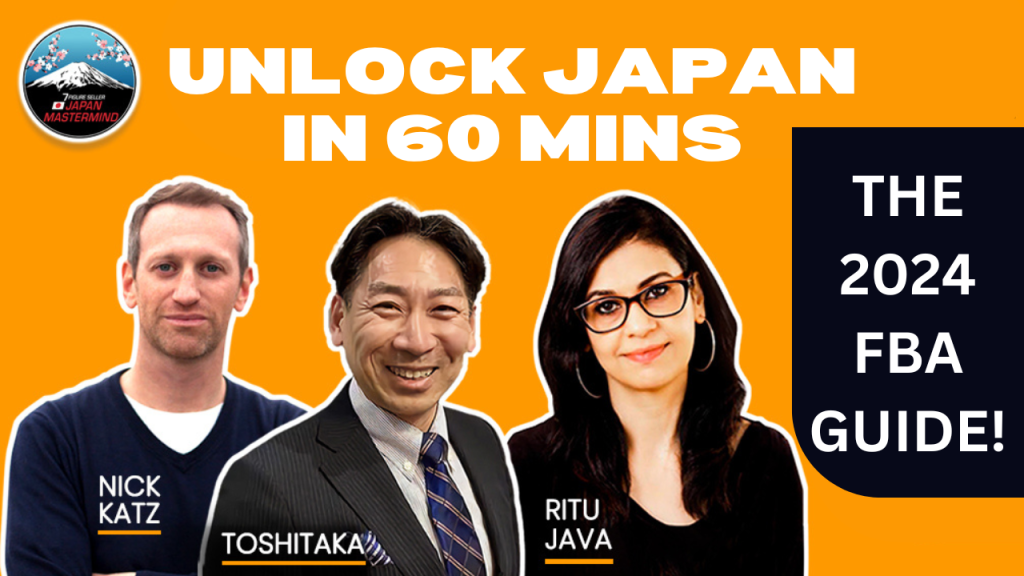
We are early in 2024 and right now is the right time for you to map out your strategy for your business if you haven’t already.
Should Japan be on your radar? I highly recommend you block out distractions, and spend some time to view this training to find out.
How to sell on Amazon Japan in 2024 – https://www.youtube.com/watch?v=2kz8MXL-amk
-Gary
PS: If you are SERIOUS about selling up to $1.2 million in additional revenue in Japan this year, join us at the 7 Figure Seller Japan Mastermind – our in person conference for sellers who want to get the roadmap to sell into Amazon Japan. You will be able also network with 8 and 7 figure Amazon Japan sellers and ecom experts like Nick, Ritu, Toshitaka, and more – join us in Japan Apr 8-10, 2024
Japan is the new niche for Amazon selling
The Amazon marketplace where you don’t need to niche down
Hi Everyone,
“The riches are in the niches” is a motto for many Amazon sellers.
Everyone knows that you need to niche down to find a profitable product. In other words you shouldn’t sell a generic “thick yoga mat” because that market is too saturated.
Literally 1000s of sellers on amazon.com selling this – with tons of reviews.
Instead, you should “niche down” to sell yoga mats that are “thick”, “non slip”, and come with a “nylon strap”.
The thinking is that the primary keyword has too much competition, so you need to niche down to find a more niche search term. Even though the keyword search volume for a niche product is lower, there is still enough search volume to make it worthwhile with less competition.
But recently, I discovered that there is still an Amazon marketplace where you don’t need to niche down.
I had a chat with 7 Figure Amazon Japan Seller Nick Katz.
I asked him “How do you find the right niche to sell on Amazon Japan?”
He said something totally against conventional Amazon guru wisdom.
“Japan IS the niche!”
The market in Amazon Japan is not as saturated with so many sellers.
For example, let’s compare the top search results for “thick yoga mat” on Amazon.com (US) versus Amazon.co.jp (Japan).
Amazon.com US search result for “thick yoga mat”
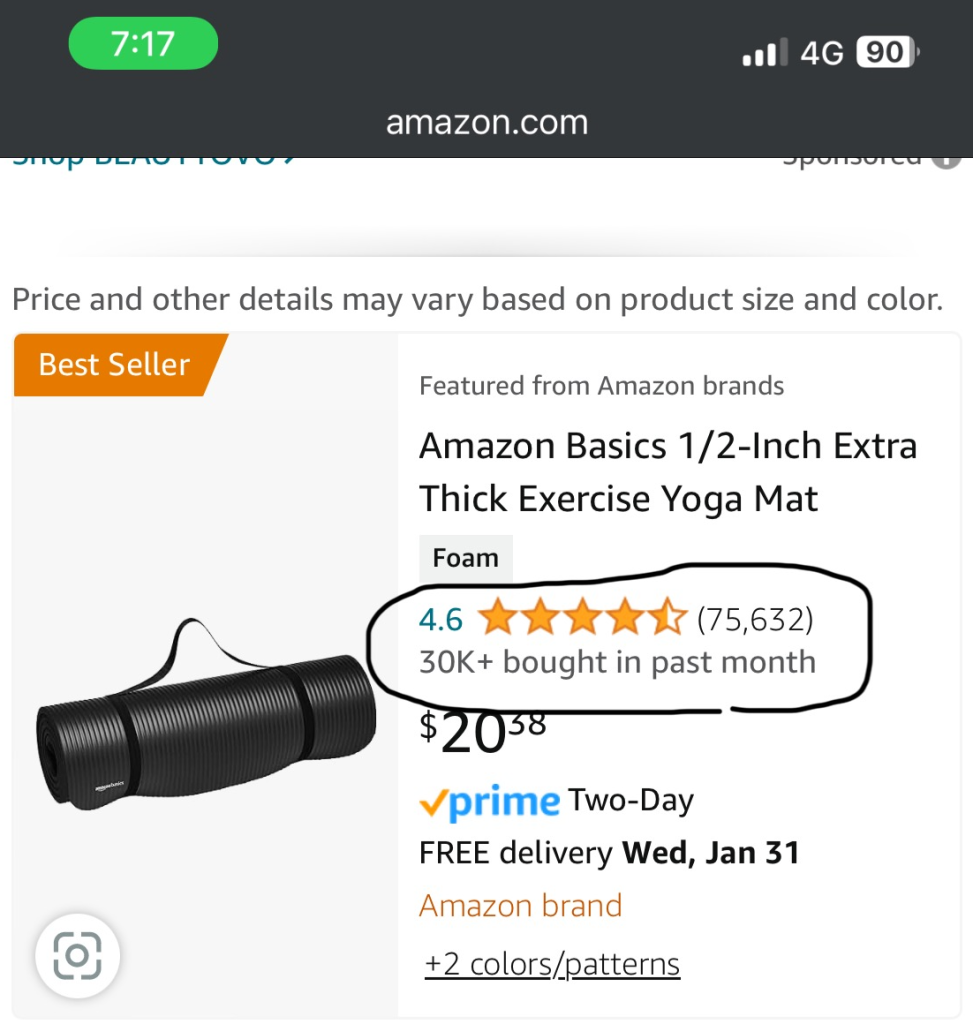
You can see the bestseller is an Amazon Basics product with 4.6 stars and 75,000+ reviews. The top sponsored product result also has 4.6 stars and 7,300+ reviews. That’s a VERY competitive niche.
Now here’s the same Search result for “thick yoga mat” on Amazon.co.jp (JS):
The Amazon JP Bestseller only has 3.9 stars and 373 reviews.
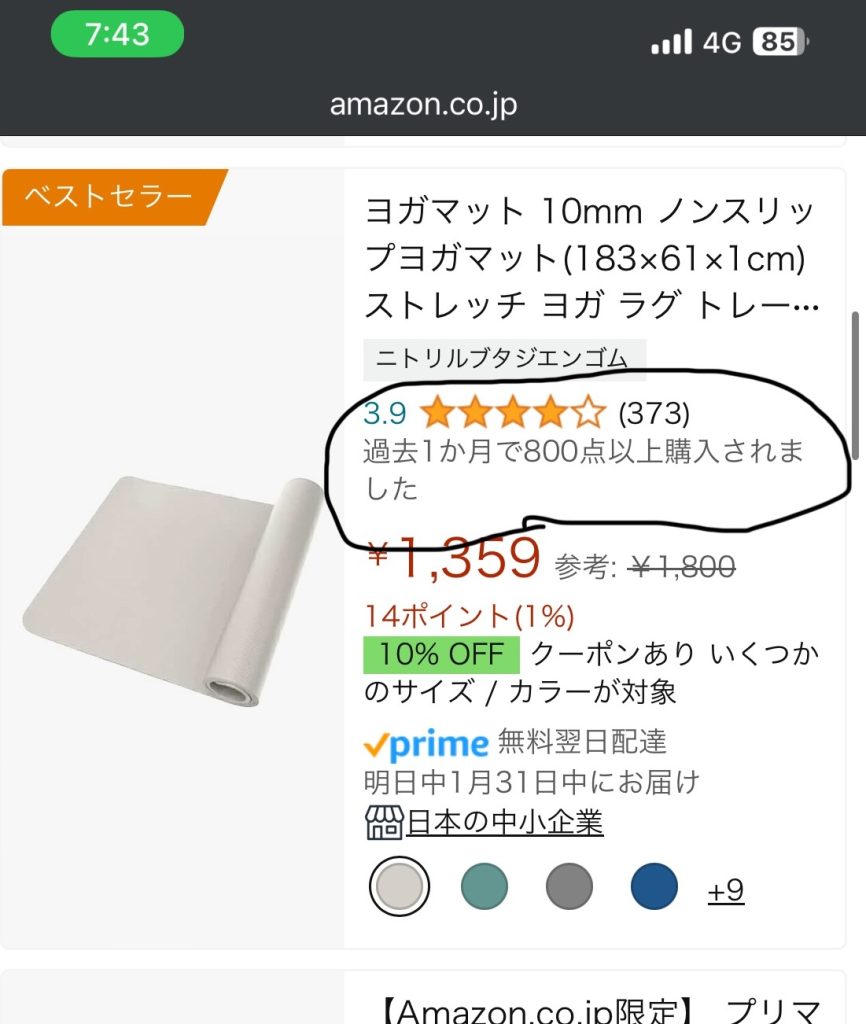
You can tell that the only reason people are buying this thick yoga mat is because there’s no better option. There’s no superior alternative.
This is why Japan is such a great market.
Think about it, who would you rather compete against?
A 4.6 star product with 75,000+ reviews product or a 3.9 star product with 373 reviews?
Even if you’re not the best seller in the world, Even if you do an OK job and develop a better product and do well with PPC, with localization and translations, you have a pretty good chance of beating someone like that.
And you can be miles ahead of your competitors and take a big piece of the pie in Japan.
And best of all, we’re not just talking about yoga mats.
Japan is still one of the ripest markets in the world.
We’re talking niches that are still wide open such as home and kitchen, baby, pet products, and many other niches that have been totally saturated in other marketplaces.
This means that there still is an opportunity in Amazon JP for “thick yoga mat” if you can come in with a better quality product.
Think about it – you can put the same amount of time and effort to sell in Japan versus US.
If you do it the right way, you can absolutely CRUSH it in Japan and in the US, you probably will barely get noticed.
To be successful on Amazon you need to have at least a 4.0 and ideally a 4.3 star rating. That way visually it looks like you have 4.5 stars when your listing shows up in the search results.
Think about it, as an Amazon shopper would you buy a product if it only looked like it had a 3.5 star rating?
I wouldn’t. If I saw that, I would suspect there’s something wrong with it.
Otherwise there’s no way it has such a low review.
And Amazon actually will give your listing more ranking juice if it can maintain a 4.3+ star rating because that delivers a better CUSTOMER EXPERIENCE – which is good for Amazon and good for it’s shoppers.
The cool part about this is that here in Japan, you can still become an early adopter… even in 2024.
The bestselling “thick yoga mat” in Japan only has 3.9 stars with 373 reviews.
In the US that’s unheard of. Literally you would have to turn back the clock to 2014 to see reviews this low and competition this weak.
I know what you’re thinking.
It sounds intimidating to sell in Japan. With the language barrier. The cultural differences. The import and compliance regulations. The taxes.
But I’ve been selling on Amazon Japan for several years now (without speaking the language).
The reality is it’s not necessarily more difficult. It could be easier. But it’s just different.
You can absolutely do it yourself in 2024.
We’ve put together several guides which you can checkout here and here.
But if you really want to sell up to an additional $300k to $965k this year in Japan, we have an in person event in Okinawa Japan Apr 8-10 that I’d like to invite you to checkout: here: https://7figuresellerjapanmastermind.com/
-Gary
PS: Pre-event ticket pricing expires Jan 31, 2024 so don’t delay to save $400 on your ticket. https://7figuresellerjapanmastermind.com/
Announcing the Japan Mastermind 2 Live in Okinawa Japan – Apr 8-10, 2024
Today I’m super excited to announce that we will launch 7 Figure Seller Amazon Japan Mastermind 2 LIVE in Okinawa Japan from Apr 8-10, 2024.

Amazon Japan is the 4th largest Amazon marketplace in the world and there is still almost nobody talking about it.

But virtually nobody is talking about selling in Japan!
In fact I see more podcasts devoted to selling in the UAE, Canada, and even relatively tiny marketplaces in comparison like the Netherlands and Poland than Japan!
In fact, compared to other countries, Japan has the 8th (EIGHTH) most sellers according to a recent study by Stastica.
This means that there is a huge opportunity!
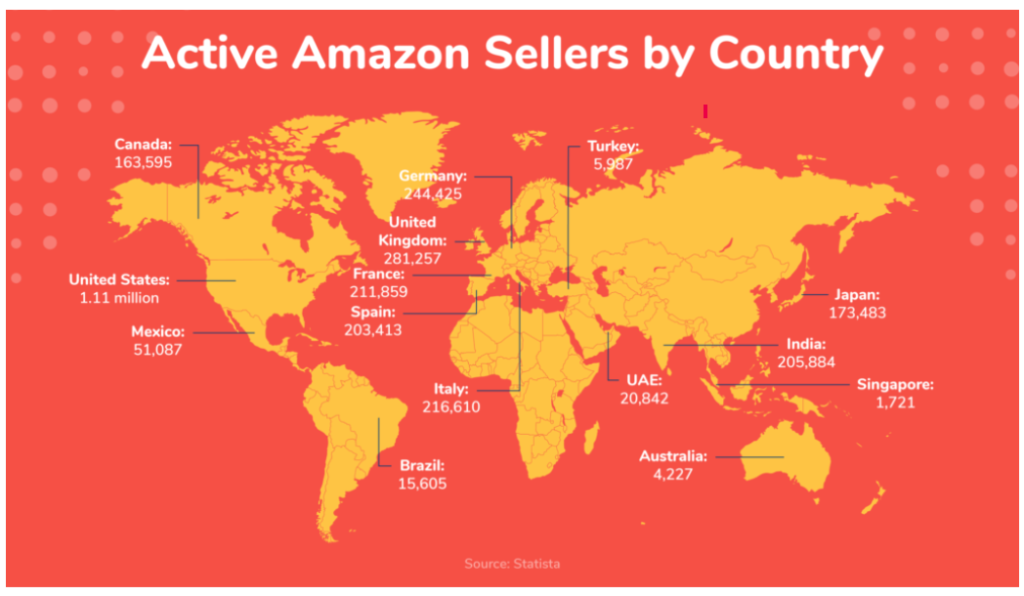
This means
- Less competition and Less sophisticated sellers competing against you
- Lower PPC costs
- No need to register for VAT or GST starting out in Japan
- Easier to grow sales and make more money than UK and Germany
- Easier to build an audience
- Easier to dominate the market
Here’s what people are saying about 7 Figure Seller Japan Mastermind
“ I’m excited about the opportunity to expand. Like I said, I think our supply chain is right there… I’m there to learn. I’m there to to expand my business as well. I think if we can plug in Japan at some point this year, it will be a big win for us. It’s definitely a marketplace that is lowest hanging fruit, with margin compression with the cost of goods going up with PPC going up in America. We got to look for opportunities to turn our money over faster to raise our bottom line at the end of the year. I think Japan represents a place where it’s not much disruption to your supply chain and his low hanging fruit. I think that’s a great opportunity.” – Brandon Young, 8 Figure Seller and founder of Data Dive
So now is the time to enter Amazon Japan.
A lot of people don’t know how to start selling into Japan.
There a lot of misconceptions about selling in Japan as well.
- Some people think that you have to be fluent in Japanese.
- They think you need to register a company in Japan.
- Or register VAT or EORI.
That simply is not true.
So to help sellers enter the Japanese Amazon market and to DEBUNK those myths about Japan I am launching the 7 Figure Seller Japan Mastermind 2 – a 3 day in person conference to show you the roadmap to selling up to $965,000 in Japan.
In this two day mastermind limited to 100 motivated sellers, you will learn:
- The UPDATED 2024 Roadmap to Selling into Amazon Japan
- Secret Launch strategies that are unique to Japan (throw out your US/EU launch playbook)
- External marketing strategies native to Japan (beyond PPC)
- Make all the connections you need to sell into Amazon Japan – importer of record, warehousing, accountants, trademark agencies, translators and more
- The A to Z of How to sell into Amazon Japan even if you don’t speak any Japanese
- Find exact product compliance requirements for your product to be imported into Japan
- NEW: Learn to sell on Rakuten Japan – the other large online marketplace
- NEW: How to get your products into offline retail stores in Japan
- NEW: AI strategies to grow your Japan business quickly: Where to leverage AI and where you shouldn’t
- Avoid most common mistakes sellers make when selling into Japan (Japan is not US or EU)
Not only that you will also get a once in a lifetime experience as it will in Okinawa aka the “Hawaii of Japan”.
Learn more about the event and see the event details here:
Besides the 2 days of the conference we will have a 3rd “Fun Day” where you will be able to
- Snorkel with Tropical fish in beautiful coral reefs
- Kayak in Yambaru mangroves (a UNESCO recognized national forest in northern Okinawa)
- Visit Churaumi Aquarium and see whale sharks and giant mantas and feed dolphins
- Go deep sea fishing
- Savor Authentic Okinawa Izakaya food and drinks
- Learn Karate from the birthplace of Kar
- Okinawa Traditional Music Lesson – San shin (3 stringed lute)
- Okinawa cooking lessons
We have a special SUPER early bird pricing which expires Dec 31st, 2023 at 11:59PM PST.
See more at https://7figuresellerjapanmastermind.com/
80/20 of E-Commerce – October 13, 2023
Hi Everyone,
In this week’s edition of 8020 of E-com Newsletter, find out how U.S. online holiday sales are on track to hit over $221 billion, offering you more opportunities in the e-commerce world. We’re also introducing you to the revamped Amazon Vine Reviews Program, now with cost-friendly options, helping you ace your product reviews game.
Amazon is making strides with the relaunch of Seller Fulfilled Prime, making it easier for your business to earn that sought-after Prime badge. Plus, USPS has shared important holiday shipping deadlines for 2023, ensuring your packages reach your customers on time.
In the mix, we’ve got a special spotlight on Ben Leonard’s book launch, packed with insights from an e-commerce pro. Don’t forget to mark your calendar for our upcoming webinar on “Balancing 2 Supply Chain (China + Thailand) in your Amazon FBA Business.”
U.S. Online Holiday Sales Set to Exceed $221B
The holiday season is just around the corner, and it’s time to gear up for the biggest online shopping event of the year. According to Adobe Analytics, online holiday sales between November 1 and December 31 are projected to skyrocket to $221 billion this year, a 4.8% increase from last year. What’s even more fascinating is the rise of “buy now, pay later” services, expected to drive a jaw-dropping $17 billion in online spending—up from $14.5 billion in 2022.
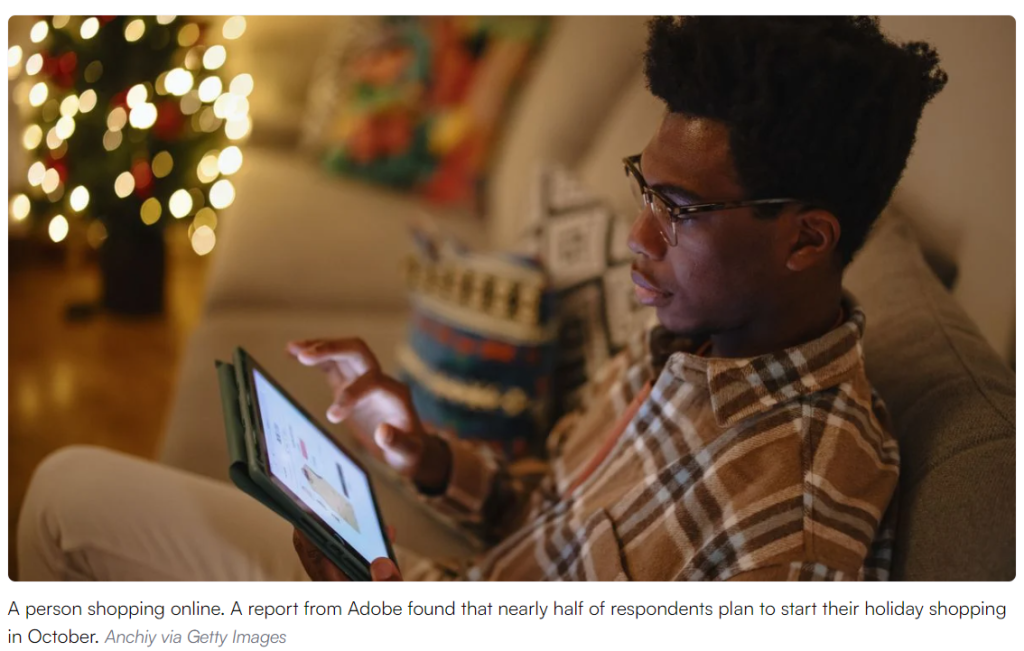
Adobe’s data dives deep into the categories to be discounted the most, with toys taking the lead at 35%, followed by electronics (30%), apparel (25%), and more. Plus, get ready for a significant shift as more than half (51.2%) of online spending will happen on mobile devices, overtaking computer-based shopping for the first time. With mobile devices accounting for more than half of all online spending, it’s important to optimize your website for mobile users.
As an e-commerce seller, you don’t want to miss out on this opportunity to boost your sales. Start preparing your website and marketing campaigns now to take advantage of the holiday shopping frenzy. Offer discounts on popular items such as toys, electronics, and apparel.
TAKEAWAY: Why should you care about this? Well, it’s your golden ticket to understanding the upcoming holiday season’s potential. With the rise of “buy now, pay later” and shifting spending habits, it’s time to adapt your e-commerce strategies for the most wonderful time of the year. Get ready to make the most of this opportunity!
Amazon Vine Reviews Program Introduces Lower-Priced Tiers
Starting October 19, 2023, the Amazon Vine Reviews Program is rolling out a brand-new pricing structure, making it accessible to brands with varying budgets. Amazon Vine is an exclusive club of Amazon’s most insightful reviewers, known as Vine Voices, who get to test products for free and share their experiences with customers. It’s like your secret weapon for obtaining valuable reviews and helping customers make informed choices.
Participating in this program can give your sales a boost of up to 30%, improve your product’s discoverability, drive conversions, and provide priceless product insights. Once you’re in, you can request products from thousands of Amazon brands, shipped right to your door for free. You use these products and provide honest reviews – whether they’re positive, neutral, or negative. Your reviews will appear alongside others on Amazon, and you’ll be recognized with a special “Vine Customer Review of Free Product” badge.

But here’s the real scoop: Amazon is introducing two brand-new, wallet-friendly tiers to make the Vine program accessible to brands with diverse budgets and products.
- $0 Tier: Enroll up to 2 units per parent ASIN and receive 2 quality Vine reviews for free.
- $75 Tier: Enroll up to 10 units per parent ASIN and snag 10 Vine reviews.
- $200 Tier (Existing): Enroll up to 30 units per parent ASIN and secure 30 Vine reviews.
One essential detail to keep in mind: these new pricing tiers apply to products enrolled on or after October 19, and the Vine enrollment fee only kicks in if you enroll in three or more units and receive the first review within 90 days. Regular FBA fees and other charges still apply.
TAKEAWAY: This is your golden opportunity to enhance your Amazon presence, gather insightful reviews, and drive your sales to new heights. Get ready to take full advantage of this program’s potential and grow your business.
Amazon Relaunches Seller Fulfilled Prime
Amazon has officially reopened enrollment for its Seller Fulfilled Prime program, offering third-party sellers the chance to manage their own fulfillment while maintaining Amazon Prime’s delivery standards.
Initially, Amazon had proposed a 2% fee on sales through this program. However, they’ve taken heed of seller feedback and decided to forgo this additional charge, ensuring it doesn’t discourage sellers from participating. Their commitment is to facilitate program access without added financial burdens.
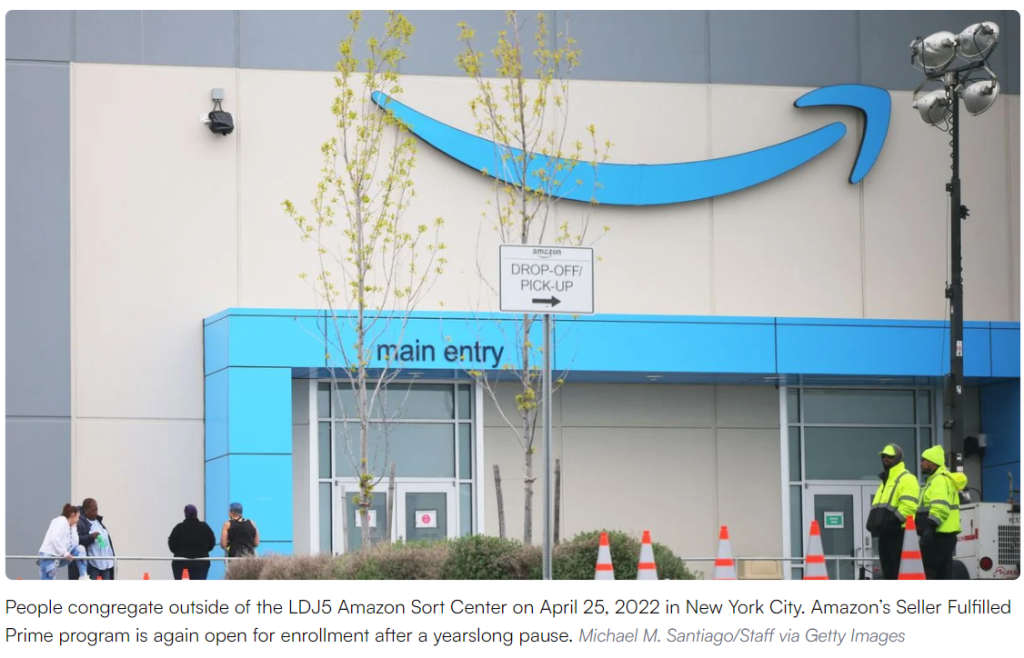
Amidst an FTC lawsuit probing Amazon’s impact on alternative delivery methods, Seller Fulfilled Prime reopens after a brief 2019 pause. To join, you’ll need to pre-qualify by meeting specific criteria like consistently delivering 100 packages on time. The trial lasts 30 days, with strict requirements, including a 93.5% on-time delivery rate and free one-day/two-day Prime shipping.
TAKEAWAY: For e-commerce pros and Amazon sellers, this means a chance to expand, speed up deliveries, and sport the Prime badge on your products. It’s a big step forward for your Amazon journey.
USPS Announces Holiday Shipping Deadlines 2023 and Raise Rates in January 2024
The U.S. Postal Service (USPS) has just unveiled the 2023 holiday shipping and mailing deadlines, ensuring you’re well-prepared to deliver cards, gifts, and packages by December 25th. It’s a great heads-up to keep your customers merry and avoid any hiccups.
Great news, USPS won’t be springing any surprise holiday surcharges this season. This offers you cost predictability during your busiest time of the year. USPS maintains its straightforward, upfront pricing throughout the year, with no extra fees for residential area delivery, Saturday delivery, fuel surcharges, or volume minimums. It remains your most cost-effective partner for holiday shipments.
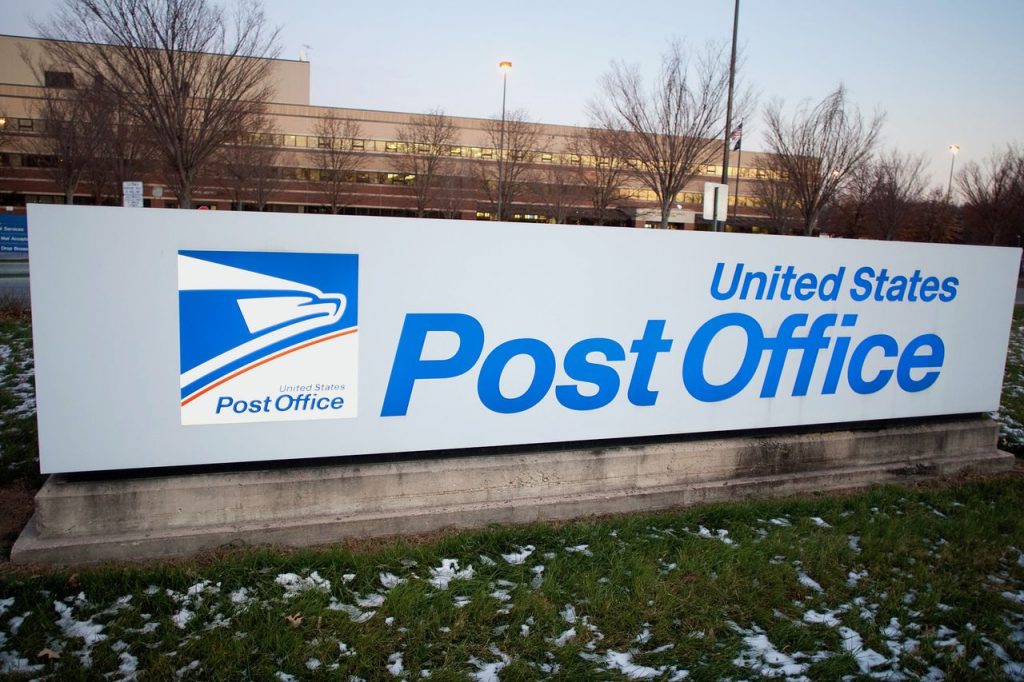
Here are some quick shipping deadlines for the Lower 48, Alaska, Hawaii, and even international destinations. Plan accordingly:
- USPS Ground Advantage — Dec. 16
- First-Class Mail (including greeting cards) — Dec. 16
- Priority Mail — Dec. 18
- Priority Mail Express — Dec. 20
A valuable addition this year is USPS Ground Advantage, offering reliable, affordable shipping with a specific delivery window of 2-5 business days based on distance. And don’t forget, you can use the USPS shipping platform Click-N-Ship for labels and schedule free carrier pickups.
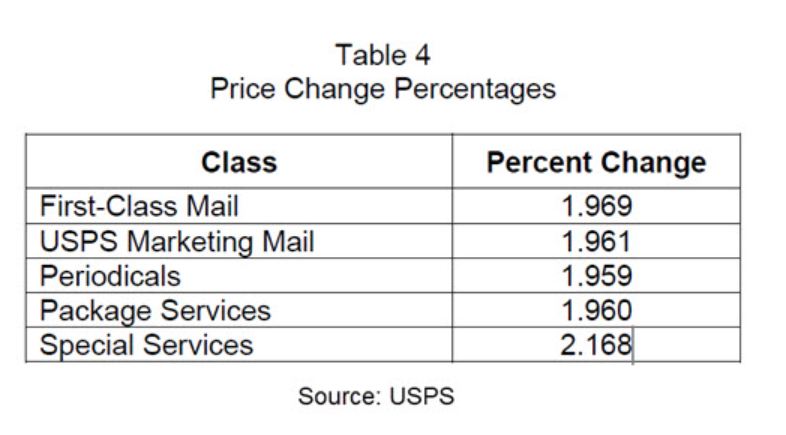
But there’s more – the USPS is making changes in January 2024. They’re raising rates, citing inflation, with a 2-cent increase in mailing a First-Class Mail letter. While they acknowledge these adjustments are necessary, they aim to maintain affordability.
TAKEAWAY: These shipping deadlines are your blueprint for holiday success. By staying on top of USPS’s schedule, you can ensure your customers receive their orders on time, all while keeping your shipping costs under control.
Limited Time Offer: Advance Access to E-commerce Mastery
Remember I shared about Ben Leonard’s upcoming book “Quit Stalling And Build Your Brand“? It’s a practical, step-by-step guide to mastering e-commerce based on solid business principles and legit experiences growing his own multi-million-dollar brands and working with dozens of consulting clients.
Well, I have exciting news. You can now get advanced access to some of its key learnings – but only if you act quickly.

Join the waitlist at www.quitstallingbook.com/7fss today, and you’ll receive:
- A free chapter of the book is available immediately.
- A powerful Entrepreneurship Mindset Mini Course.
- The handy E-commerce Hacks eBook.
- Priority access to the book launch ahead of the general public.
This is a limited-time offer. Don’t wait. Grab this chance to jumpstart your journey to e-commerce success.
The Unspoken Truth About Canton Fair
Today I want to share with you a secret.
In my over-a-decade-long journey as a China sourcing expert, there’s a secret I’ve never shared: I’ve never personally attended the Canton Fair. Why, you may wonder?

Here’s why Canton Fair Isn’t on My Radar (And Maybe Shouldn’t Be On Yours):
- Broad and Unfocused: Canton Fair’s sheer size can lead to a wasteful use of time. Rather than wandering for weeks, your time is better spent at industry-specific trade shows, where you can efficiently find the products you’re after.
- Scarcity: The Canton Fair takes place only twice a year (April and October), which may not align with your immediate sourcing needs.
- Hidden Treasures: The most innovative products aren’t displayed openly; they’re concealed behind curtains or within private locations.
- Not the First Choice for Top Suppliers: Many premium suppliers opt for industry-specific shows, where they can engage with serious buyers.
Case in point: While I was growing one of my early six-figure private label brands on Amazon, I discovered my top kitchen supplier at a specialized kitchen trade show in Shanghai, not at the Canton Fair. Interestingly, when I inquired, they mentioned they didn’t find it worthwhile to attend the Canton Fair for the same reasons I’ve highlighted.
The Truth About Sourcing:
While the Canton Fair has its place, it’s become more of a trend among Amazon FBA sellers and “gurus” to promote paid sourcing trips rather than offering practical advice.
Supply chain experts agree that the Canton Fair is a relic from the pre-internet era, and there are better solutions available today. A great way to improve your sourcing is by working with a knowledgeable sourcing agent. They have established networks, attend key trade shows throughout the year, and can communicate effectively with suppliers.
If you’re interested in this approach, please sign up through our sourcing request form:
Remember, Canton Fair is an option, but it’s not a necessity.
WEBINAR: “Balancing 2 Supply Chain (China + Thailand) in your Amazon FBA Business” – Thursday, October 19, at 9 pm EST
The sourcing landscape has been rapidly changing in recent years, particularly in the wake of the pandemic. China remains a global manufacturing leader, but new uncertainties have emerged. Amidst these changes, fresh opportunities to source your products have also arisen.
We are thrilled to invite you to our upcoming webinar featuring Mike Michelini, founder and host of Global from Asia and Organizer at Cross Border Summit. Based in Thailand, Mike will provide insights from his real-world experience sourcing in Thailand, while we will also delve into China sourcing best practices for 2024.
This is a unique opportunity to learn from two industry-leading experts with a combined 25 years of on-the-ground experience in China and Thailand, both in sourcing and business. You’ll have the chance to engage in live Q&A, ensuring your specific questions are addressed.
In this webinar, you will gain valuable insights into:
- Effectively managing and harmonizing supply chains in both China and Thailand, harnessing the power of the “China plus 1” trend.
- Navigating your existing relationships with Chinese factories and suppliers while considering the prospects beyond China’s borders.
- Tackling the challenges and adopting best practices for packaging, branding, and mold selection in your business.
- Approaches to expanding your product portfolio while striking a balance between existing and new offerings.
- The art of creating and experimenting with a “new brand” within your business, aligning with your budget and timelines.
- Discerning the critical distinctions between supply chains in China and Thailand, alongside the growing array of logistics options beyond China’s borders.
- Understanding the importance of risk diversification as a business owner and the benefits it can bring to your overall operations.
Don’t miss this exclusive training session scheduled for next Thursday, October 19th at 9 pm EST.
Secure your spot now by RSVPing here: https://bit.ly/48HRRHU
We look forward to having you join us for this insightful webinar.
PPC Mastery Summit Q4 Edition, October 24-26, 2023
The holiday season presents a massive opportunity for huge sales in a short period of time, and paid advertising is still the best way to profitably drive sales in the fourth quarter… if done right.
If not done well, your profits can be gobbled up by the extra ad spend around the holidays.
It is important to stay on top of the latest trends with paid ads so that you can profitably drive more sales and stay ahead of your competitors. And it becomes even more important during the busy holiday season.
That is why I am excited to share with you the upcoming PPC Mastery Summit Q4 Edition put on by Maximizing E-commerce from Tuesday, October 24 – Thursday, October 26, 2023.
They have brought together amazing speakers who are going to share actionable strategies for you to drive more sales this holiday sale (and do it profitably).
It is hard to go out to a restaurant and pay less than they are charging for a ticket. This is the best value in learning with some of the most respected leaders in the industry. You won’t want to miss this…
CLICK HERE to grab your ticket to the summit: https://bit.ly/493lsfo
Are you ready to take your PPC ads to the next level this holiday season (and beyond)?
In case you missed it:
- Amazon Advises Sellers to Get Their Holiday Inventory into Warehouses
- AWS Announces Powerful New Offerings to Accelerate Generative AI Innovation
- Amazon Expanding Program in Which Items Ship Without Added Packaging
- How FTC’s Historic Monopoly Case vs. Amazon Might Impact Sellers
- Prepare Your E-commerce Business for CNY 2024!
- LA Amazon Sellers Meetup in December
Until next time,
Gary
80/20 of E-Commerce – October 6, 2023
Hey Everyone,
As we gear up for the holiday season and year-end, our upcoming newsletter is packed with valuable insights. From Amazon’s holiday inventory advice to Walmart’s extended return policy, we’ve got you covered. We’ll also explore Amazon’s “Ships in Product Packaging” program and China’s booming e-commerce scene.
Additionally, we’re here to help with your sourcing needs in China, and don’t forget to check out the Los Angeles Amazon Sellers Meetup in mid-December.
Stay tuned for these highlights and more in today’s edition of our 80/20 E-commerce newsletter, October 6, 2023.
Amazon Advises Sellers to Get Their Holiday Inventory into Warehouses
The holiday season is fast approaching, and Amazon is already gearing up. In a recent Retail Brew article, Amazon encourages sellers to send in their inventory early by October 26 to avoid potential disruptions caused by supply chain challenges and labor shortages during the annual influx of holiday goods.
Here’s the deal: Stock up early. By sending in your inventory ahead of time, you’ll ensure your products are readily available when holiday shoppers come knocking. It’s a surefire way to sidestep delays and stockouts, setting you up for a successful season.
As e-commerce sellers, possessing expertise in sales forecasting, supplier collaboration, mobile optimization, inventory tracking, and JIT inventory management is your winning formula for mastering Amazon’s holiday inventory challenges.
TAKEAWAY: Plan ahead and stock up early. Amazon’s holiday inventory planning, combined with effective strategies, is your ticket to e-commerce success this holiday season.
Amazon Expanding Program in Which Items Ship Without Added Packaging
Amazon is expanding its “Ships in Product Packaging” program, which allows eligible items to be delivered in the original manufacturer’s packaging without additional Amazon packaging. This program can help sellers reduce packaging waste and lower their Fulfillment by Amazon fees. According to a recent article by Retail Dive, the program will be available in 2024 for all third-party sellers using the company’s fulfillment services.
It’s not just a logistical upgrade; it’s a game-changer that deserves your attention. Amazon’s latest initiatives in product packaging and container programs aren’t just about logistics; they’re about empowering e-commerce sellers like you to boost brand recognition and potentially streamline shipping costs.
Amazon is putting the power in your hands by offering a new level of customization for product packaging. The lack of additional packaging provides several perks for sellers, including cost savings and environmental benefits. By using more compact packaging, sellers can potentially reduce transportation costs and carbon emissions by using less packaging material and taking up less space on trucks, which means fewer trips.
TAKEAWAY: Amazon’s “Ships in Product Packaging” program is a great opportunity for e-commerce sellers to reduce their environmental impact and save money on fulfillment fees. By redesigning their products’ packaging to enable them to ship in their own branded product packaging without any Amazon-added delivery packaging, sellers can streamline their fulfillment process and improve their sustainability practices.
Prepare Your E-commerce Business for CNY 2024!
China’s e-commerce market, generating a staggering $2 trillion in revenue in 2022, is a powerhouse. However, it’s important to brace for a significant disruption caused by the holidays and Chinese New Year (CNY).
CNY is like a mega-holiday, with around 340 million workers traveling to celebrate with their families. This massive migration leads to factory closures, impacting the entire supply chain. After CNY, factories scramble to hire and train new workers, causing delays that can last a month.
As an e-commerce seller, your key to success lies in planning ahead for Q1 (Jan-Mar) and Q2 (Apr-June). Despite the CNY challenge, you can secure a smooth 2024 by preparing early and ensuring your inventory lasts through the holiday season.
Feeling overwhelmed? We’re here to help! If you require assistance with sourcing requests, sign up through our link to kickstart your preparations today.
RSVP Here: https://www.8020sourcing.com/sourcing-request/
TAKEAWAY: Don’t let the holidays and CNY catch you off guard. Plan ahead, secure your inventory, and ensure a smooth 2024 for your e-commerce business.
P.S. If you need help with sourcing in China, we can help you out, simply click the link and fill out this RSVP Form
LA Amazon Sellers Meetup in December
I’m excited to share that I’ll be heading to Los Angeles this December to spend some quality time with my family. While I’m in the area, I’ve been thinking about hosting a year-end Amazon seller networking event during early to mid-December.
Would you like to be a part of it? Your thoughts and preferences matter greatly in shaping this event to make it as beneficial as possible for you.
Please take a moment to share your input by filling out our RSVP form here: https://bit.ly/46BLOTH
Your insights will play a vital role in creating an unforgettable experience for our Amazon seller community.
We’d love to have you join us! We’re looking forward to hearing your suggestions. Don’t forget to RSVP now to secure your spot.
Looking forward to connecting with you!
In case you missed it:
- Are you Looking for a Sourcing Agent in China?
- Amazon Faces Antitrust Lawsuit from FTC and 17 States
- Amazon Responds to FTC Antitrust Lawsuit – Would This Help or Hurt Your Business?
- Holiday Spending to Increase by 3.7%
- UPS to Hire 100,000 Seasonal Workers for Peak
All the best,
Gary
